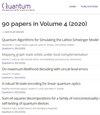Efficient Hamiltonian encoding algorithms for extracting quantum control mechanism as interfering pathway amplitudes in the Dyson series
IF 5.1
2区 物理与天体物理
Q1 PHYSICS, MULTIDISCIPLINARY
引用次数: 0
Abstract
Hamiltonian encoding is a methodology for revealing the mechanism behind the dynamics governing controlled quantum systems. In this paper, following Mitra and Rabitz [9], we define mechanism via pathways of eigenstates that describe the evolution of the system, where each pathway is associated with a complex-valued amplitude corresponding to a term in the Dyson series. The evolution of the system is determined by the constructive and destructive interference of these pathway amplitudes. Pathways with similar attributes can be grouped together into pathway classes. The amplitudes of pathway classes are computed by modulating the Hamiltonian matrix elements and decoding the subsequent evolution of the system rather than by direct computation of the individual terms in the Dyson series. The original implementation of Hamiltonian encoding was computationally intensive and became prohibitively expensive in large quantum systems. This paper presents two new encoding algorithms that calculate the amplitudes of pathway classes by using techniques from graph theory and algebraic topology to exploit patterns in the set of allowed transitions, greatly reducing the number of matrix elements that need to be modulated. These new algorithms provide an exponential decrease in both computation time and memory utilization with respect to the Hilbert space dimension of the system. To demonstrate the use of these techniques, they are applied to two illustrative state-to-state transition problems.求助全文
约1分钟内获得全文
求助全文
来源期刊

Quantum
Physics and Astronomy-Physics and Astronomy (miscellaneous)
CiteScore
9.20
自引率
10.90%
发文量
241
审稿时长
16 weeks
期刊介绍:
Quantum is an open-access peer-reviewed journal for quantum science and related fields. Quantum is non-profit and community-run: an effort by researchers and for researchers to make science more open and publishing more transparent and efficient.
 求助内容:
求助内容: 应助结果提醒方式:
应助结果提醒方式:


